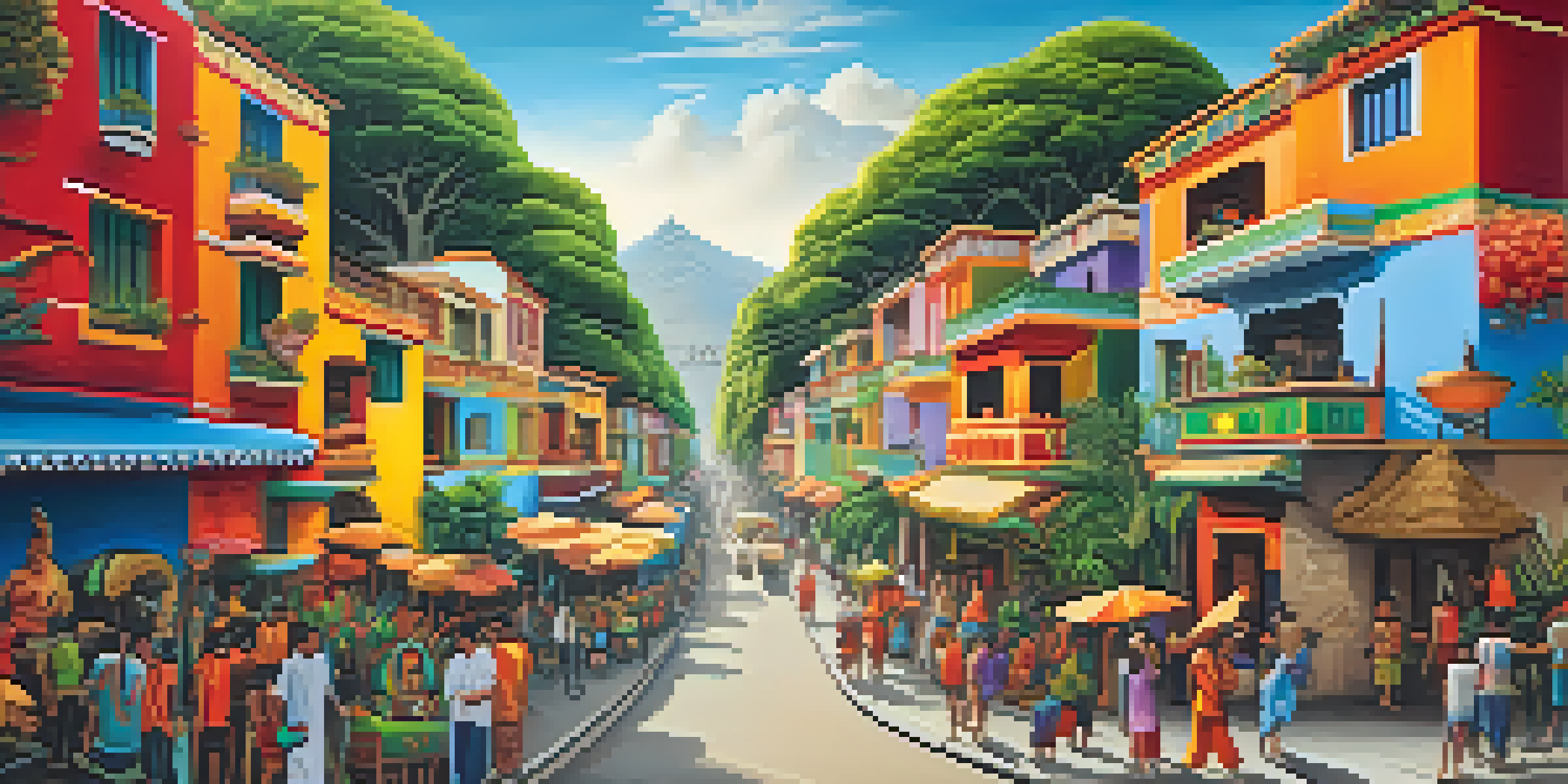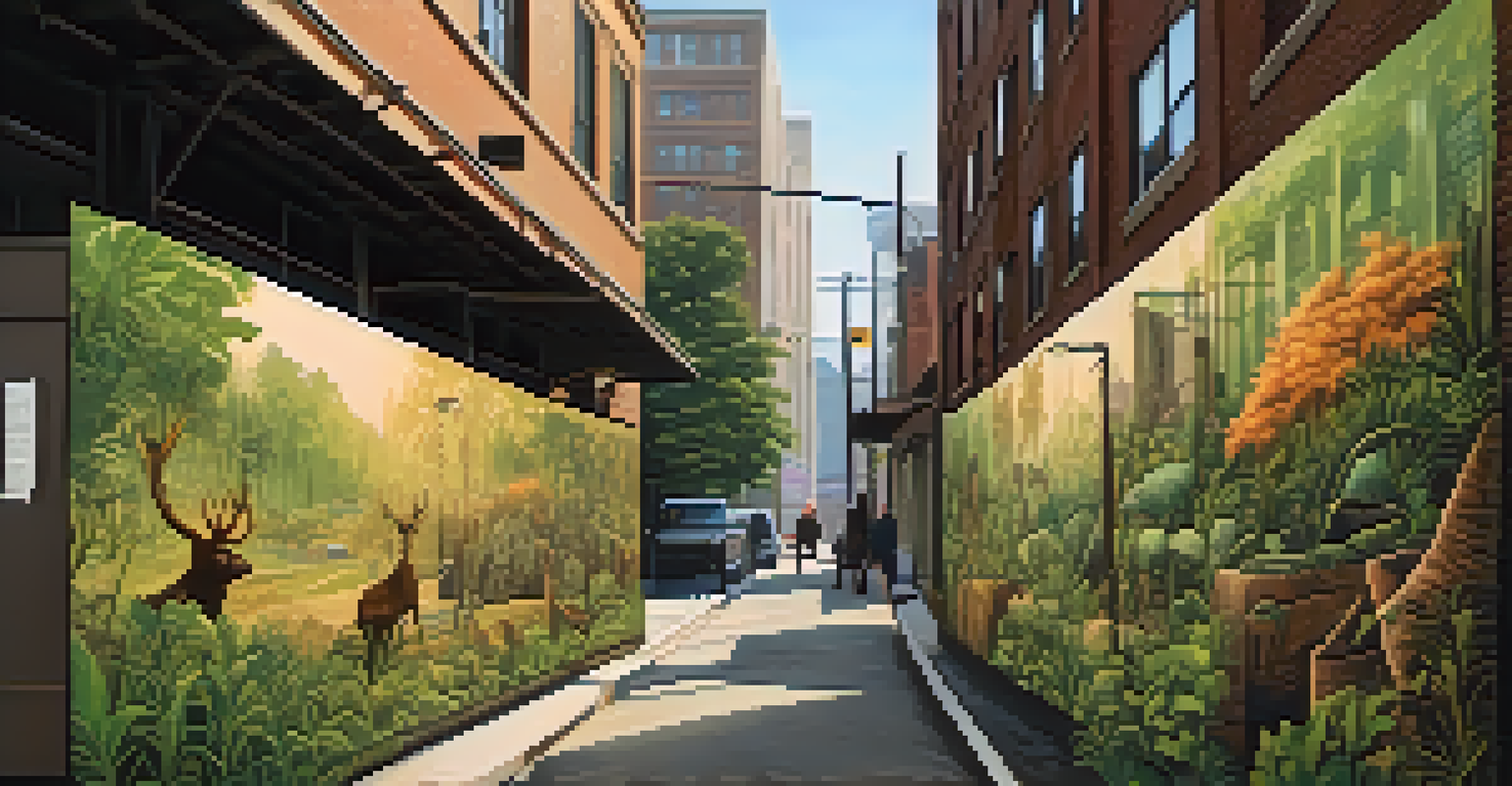The Role of Street Art in Reflecting Peruvian Cultural Identity

Street Art as a Mirror of Cultural Heritage
Street art in Peru offers a vivid representation of the country's rich cultural heritage. Artists draw inspiration from ancient traditions, folklore, and indigenous symbols, transforming public spaces into living galleries. This art form captures the essence of Peru's diverse cultures, making the past accessible to contemporary audiences.
Art is the most beautiful of all lies.
For instance, murals often depict scenes from Peruvian mythology, connecting viewers with their roots. By incorporating traditional motifs and colors, artists create a dialogue between the past and present. This not only educates the public but also instills a sense of pride in their cultural identity.
Moreover, street art serves as a canvas for cultural exchange, showcasing Peru's multifaceted identity. As artists collaborate and share ideas, they create a vibrant tapestry that represents the evolving nature of Peruvian culture. This dynamic interplay fosters a sense of unity and belonging among the community.
Social Commentary Through Street Art
Beyond aesthetics, street art in Peru often addresses pressing social issues. Artists use their work to highlight inequality, environmental concerns, and political struggles. By doing so, they not only raise awareness but also engage the community in meaningful conversations.

For example, a mural depicting the effects of deforestation can spark discussions about sustainability and conservation. This ability to convey powerful messages makes street art a vital tool for social change. It encourages viewers to reflect on their surroundings and consider their role in shaping their society.
Cultural Heritage Reflected in Art
Street art in Peru embodies the country's rich cultural heritage by incorporating traditional motifs and folklore, creating a dialogue between past and present.
Additionally, these artworks often serve as a voice for marginalized communities. By representing their stories and struggles, street artists empower individuals to reclaim their narratives. This blend of artistry and activism makes street art an essential component of Peru's cultural landscape.
The Evolution of Street Art in Urban Spaces
The evolution of street art in Peru mirrors the rapid changes occurring in urban environments. Once considered vandalism, street art has gained recognition as a legitimate form of artistic expression. Cities like Lima have embraced this transformation, with local governments promoting mural festivals and art initiatives.
Street art is a form of expression that is often overlooked but powerful in its message and its accessibility to the public.
As urban areas expand, street art has become a way to beautify and revitalize neglected spaces. Artists collaborate with communities to create murals that reflect local identity and history. This collaborative approach not only enhances the aesthetic value of neighborhoods but also fosters community pride.
Moreover, the increasing popularity of street art has attracted both local and international artists. This influx of diverse perspectives enriches the artistic landscape, creating a melting pot of styles and ideas. The result is a vibrant urban canvas that continuously evolves, reflecting the dynamic nature of Peruvian culture.
Street Art and Youth Engagement
Street art plays a crucial role in engaging Peru's youth, offering them a platform for self-expression. Many young artists find their voice through spray paint, using their creativity to explore personal and societal themes. This form of expression encourages them to share their stories and experiences with the world.
In addition to individual expression, street art also fosters community engagement among the youth. Workshops and collaborative projects invite young people to participate in the artistic process, strengthening their connection to their culture and community. This hands-on involvement instills a sense of ownership and pride in their environment.
Street Art as Social Commentary
Peruvian street art addresses pressing social issues, serving as a powerful tool for raising awareness and empowering marginalized communities.
Furthermore, street art serves as a bridge between generations, sparking dialogue between older and younger community members. As they discuss the meanings behind various artworks, they create an opportunity for cultural exchange and mutual understanding. This intergenerational connection deepens the appreciation for Peru's diverse cultural landscape.
The Role of Technology in Street Art
In today's digital age, technology has significantly influenced the evolution of street art in Peru. Social media platforms have become vital tools for artists to showcase their work, reach wider audiences, and connect with fellow creators. This online presence allows them to gain recognition beyond their local communities.
Moreover, technology has introduced innovative techniques and materials to the art form. Artists now experiment with augmented reality and interactive elements, creating immersive experiences for viewers. This incorporation of technology not only enhances the visual impact but also engages audiences in unique ways.
Additionally, online platforms facilitate collaborations across borders, enabling artists to share ideas and techniques. This global exchange enriches the local street art scene, infusing it with fresh perspectives and styles. As a result, Peru's street art continues to evolve, reflecting both local culture and global influences.
Street Art Festivals: Celebrating Creativity
Street art festivals have become a cornerstone of Peru's cultural landscape, celebrating creativity and community. Events like the 'Festival de Arte Urbano' bring together artists from various backgrounds, transforming urban spaces into vibrant art hubs. These festivals not only showcase talent but also foster a sense of camaraderie among artists and audiences alike.
During these events, attendees can witness live murals being created, participate in workshops, and engage with the artists. This immersive experience demystifies the artistic process, making it accessible to the general public. It allows viewers to appreciate the skill and effort that goes into creating street art.
Youth Engagement Through Creativity
Street art offers Peru's youth a platform for self-expression, fostering community engagement and intergenerational dialogue.
Furthermore, festivals often feature discussions and panels on the significance of street art in social movements and cultural identity. These conversations encourage reflection on the role of art in society, inviting attendees to consider how they can contribute to positive change. Ultimately, street art festivals strengthen community ties and celebrate the diverse voices that shape Peru's cultural identity.
The Future of Street Art in Peru
Looking ahead, the future of street art in Peru appears promising, with a growing appreciation for its cultural significance. As public spaces continue to evolve, artists are likely to explore new themes and mediums. This ongoing evolution will allow street art to remain relevant, reflecting contemporary societal issues and cultural shifts.
Moreover, increased support from local governments and organizations will help foster a thriving street art scene. Initiatives that promote public art and provide funding for artists will encourage creativity and innovation. This support will also ensure that street art continues to play a vital role in community engagement and cultural expression.

Ultimately, street art in Peru will continue to be a powerful medium for storytelling, reflection, and social change. As artists push boundaries and challenge norms, they will inspire future generations to embrace their cultural identity. This ongoing dialogue between art and society will solidify street art's place in Peru's cultural tapestry.